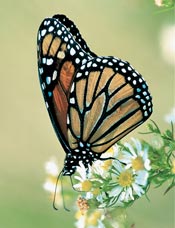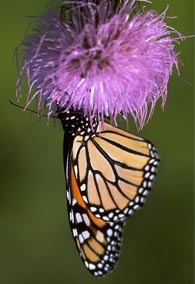Main Content
Article
Monarchs and Milkweed
 By Haley Samuelson-Couchman, Seasonal Interpretive Naturalist at Prophetstown State Park.
By Haley Samuelson-Couchman, Seasonal Interpretive Naturalist at Prophetstown State Park.
Nothing seems to signal the start of summer like the arrival of the monarch butterflies. A stunning display of bright orange and black wings makes this attractive insect a beautiful addition to any garden or prairie.
You may be wondering what brings the monarch to Indiana every summer. During the warmth of spring and summer, native wildflowers begin to grow. Among these flowers are the plants monarchs live for: the milkweeds!
The entire lifecycle of the monarch butterfly is dependent on the milkweed. It is sometimes called the “milkweed butterfly” because it is the only plant the monarch larvae, or caterpillars, can eat.
The female monarch butterfly will lay her eggs on the underside of the milkweed leaves, which provide protection for the developing larvae. The large leaves act like umbrellas, shading the eggs from too much summer sun and sheltering them during strong rainstorms. The leaves also offer an excellent hiding spot from predators that may want to eat the eggs before the larva emerges.
When the larvae hatch, they will begin to munch on the leaves of the milkweed plants, eating day and night for the first few days of life. On the first day, the larva may eat as much as its own weight in food!
The caterpillar will continue to feed on the milkweed for about two weeks. By the time it is done growing, the caterpillar will weigh about 2,700 times more than when it hatched. Can you imagine what we would weigh if that were true for humans too!
The milkweed offers more than just a delicious treat for the developing caterpillars. Milkweed provides the monarch butterflies and their larvae with a unique form of protection. The milkweed plant is poisonous, and the larvae ingest a large amount of the toxic substances found in the plant. Like the old saying “you are what you eat,” monarchs share this defense with the milkweed by storing the poison in their bodies. The bright orange color of the adult monarch’s wings warns other animals that it will not be a very pleasant insect to eat.
But what does the monarch do for the milkweed? As the adult butterfly flies from flower to flower looking for food, it helps to pollinate the milkweed. This allows the milkweed to successfully produce seeds that will grow and attract more monarchs in the years to come.
Without the milkweed plant, the monarch would not be able to survive. Together, the two species have formed a beautiful relationship that has lasted for generations.
